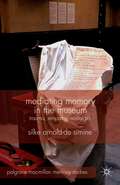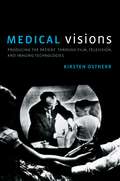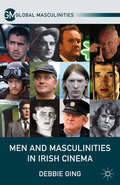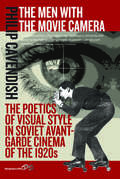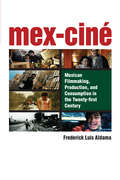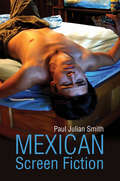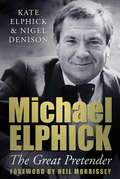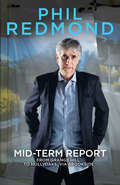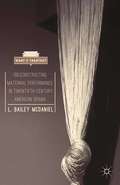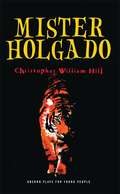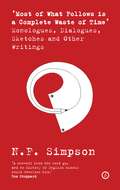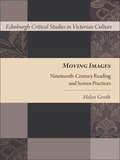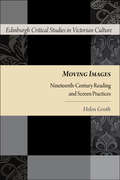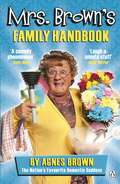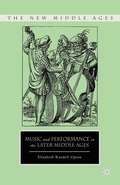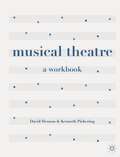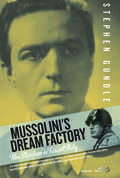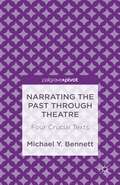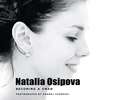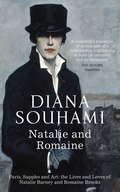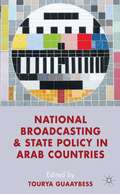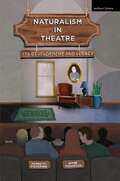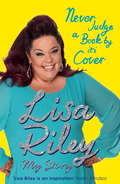- Table View
- List View
Mediating Memory in the Museum: Trauma, Empathy, Nostalgia (Palgrave Macmillan Memory Studies)
by S. Arnold-de-Simine Silke Arnold-de SimineMediating Memory in the Museum is a contribution to an emerging field of research that is situated at the interface between memory studies and museum studies. It highlights the role of museums in the proliferation of the so-called memory boom as well as the influence of memory discourses on international trends in museum cultures.
Medical Visions: Producing the Patient Through Film, Television, and Imaging Technologies
by Kirsten OstherrHow do visual images shape the practice of medicine? What role does visual representation play in the cultivation of medical ways of seeing? And how has medicine's visual culture changed in the digital age? Kirsten Ostherr's ambitious study explores 120 years of medical image-making to explain how visual representations shape medical education and practice. Marshaling powerful, vivid examples she demonstrates how medical images created by the healthcare industry, documentary filmmakers, experimental artists, and the mass media acquire cultural meaning and influence doctors' and patients' understandings of health and disease. Her analysis proceeds chronologically, turning from the earliest experiments with medical filmmaking by the American College of Surgeons, to the place of health films in the "golden age" of instructional film in the 1960s. Ostherr considers the shift to television as the dominant medium of health education, highlighting the evolving status of realism, the techniques employed to bridge the entertainment-education divide, the role of expert consultants and sponsors, and the tradeoffs made by professionals to reach a broad audience. The rise of physician advice segments on newsmagazines forms a transition between medical dramas like Marcus Welby, MD and more recent reality shows like Boston Med and Doctor 90210. Concluding with a section on advertising and social media in the health care setting, the book ends with ten key lessons for the future of medical media.
Men and Masculinities in Irish Cinema (Global Masculinities)
by D. GingSpanning a broad trajectory, from the New Gaelic Man of post-independence Ireland to the slick urban gangsters of contemporary productions, this study traces a significant shift from idealistic images of Irish manhood to a much more diverse and gender-politically ambiguous range of male identities on the Irish screen.
The Men with the Movie Camera: The Poetics of Visual Style in Soviet Avant-Garde Cinema of the 1920s
by Philip CavendishUnlike previous studies of the Soviet avant-garde during the silent era, which have regarded the works of the period as manifestations of directorial vision, this study emphasizes the collaborative principle at the heart of avant-garde filmmaking units and draws attention to the crucial role of camera operators in creating the visual style of the films, especially on the poetics of composition and lighting. In the Soviet Union of the 1920s and early 1930s, owing to the fetishization of the camera as an embodiment of modern technology, the cameraman was an iconic figure whose creative contribution was encouraged and respected. Drawing upon the film literature of the period, Philip Cavendish describes the culture of the camera operator, charts developments in the art of camera operation, and studies the mechanics of key director-cameraman partnerships. He offers detailed analysis of Soviet avant-garde films and draws comparisons between the visual aesthetics of these works and the modernist experiments taking place in the other spheres of the visual arts.
Mex-Ciné: Mexican Filmmaking, Production, and Consumption in the Twenty-first Century
by Frederick L AldamaMex-Cinéoffers an accessibly written, multidisciplinary investigation of contemporary Mexican cinema that combines industrial, technical, and sociopolitical analysis with analyses of modes of reception through cognitive theory. Mex-Cinéaims to make visible the twenty-first century Mexican film industry, its blueprints, and the cognitive and emotive faculties involved in making and consuming its corpus. A sustained, free-flowing book-length meditation, Mex-Ciné enriches our understanding of the way contemporary Mexican directors use specific technical devices, structures, and characterizations in making films in ways that guide the perceptual, emotive, and cognitive faculties of their ideal audiences, while providing the historical contexts in which these films are made and consumed.
Mexican Screen Fiction: Between Cinema and Television
by Paul Julian SmithMexican cinema is booming today, a decade after the international successes of Amores perros and Y tu mamá también. Mexican films now display a wider range than any comparable country, from art films to popular genre movies, and boasting internationally renowned directors like Alfonso Cuarón, Alejandro González Iñárritu, and Guillermo del Toro. At the same time, television has broadened its output, moving beyond telenovelas to produce higher-value series and mini-series. Mexican TV now stakes a claim to being the most dynamic and pervasive national narrative. This new book by Paul Julian Smith is the first to examine the flourishing of audiovisual fiction in Mexico since 2000, considering cinema and TV together. It covers much material previously unexplored and engages with emerging themes, including violence, youth culture, and film festivals. The book includes reviews of ten films released between 2001 and 2012 by directors who are both established (Maryse Sistach, Carlos Reygadas) and new (Jorge Michel Grau, Michael Rowe, Paula Markovitch). There is also an appendix that includes interviews carried out by the author in 2012 with five audiovisual professionals: a feature director, a festival director, an exhibitor, a producer, and a TV screenwriter. Mexican Screen Fiction will be an invaluable resource for students and scholars and essential reading for anyone interested in one of the most vibrant audiovisual industries in the world today.
Mexican Screen Fiction: Between Cinema and Television
by Paul Julian SmithMexican cinema is booming today, a decade after the international successes of Amores perros and Y tu mamá también. Mexican films now display a wider range than any comparable country, from art films to popular genre movies, and boasting internationally renowned directors like Alfonso Cuarón, Alejandro González Iñárritu, and Guillermo del Toro. At the same time, television has broadened its output, moving beyond telenovelas to produce higher-value series and mini-series. Mexican TV now stakes a claim to being the most dynamic and pervasive national narrative. This new book by Paul Julian Smith is the first to examine the flourishing of audiovisual fiction in Mexico since 2000, considering cinema and TV together. It covers much material previously unexplored and engages with emerging themes, including violence, youth culture, and film festivals. The book includes reviews of ten films released between 2001 and 2012 by directors who are both established (Maryse Sistach, Carlos Reygadas) and new (Jorge Michel Grau, Michael Rowe, Paula Markovitch). There is also an appendix that includes interviews carried out by the author in 2012 with five audiovisual professionals: a feature director, a festival director, an exhibitor, a producer, and a TV screenwriter. Mexican Screen Fiction will be an invaluable resource for students and scholars and essential reading for anyone interested in one of the most vibrant audiovisual industries in the world today.
Michael Elphick: The Great Pretender
by Kate Elphick Nigel DenisonMichael Elphick was a young electrician working at the Chichester Theatre when he was discovered by Laurence Olivier, who arranged for him to join the Central School of Drama. It was here where he met Bruce Robinson, who would later cast him in one of the most popular British films of all time – Withnail and I. Elphick’s illustrious career also included major supporting roles in films such as Quadrophenia, The Elephant Man, Gorky Park and Dennis Potter’s Blue Remembered Hills. On television, there was Private Schultz and Boon, which gave his acolyte and friend, Neil Morrissey, his first starring role. One of his characters’ owned houses in Coronation Street whilst another wooed Peggy Mitchell in Eastenders. However, Elphick’s private life was every bit as varied as his acting career. Racked by alcoholism and devastated by the early death of his partner, Julia, Elphick died at the age of 55. And yet, his friends and family will always remember his hugely humorous personality, and everyone he met was left with a ‘Mike Elphick story’...
Mid-Term Report: From Grange Hill To Hollyoaks, Via Brookside
by Phil RedmondA masterclass in media studies from the creator of Grange Hill, Brookside and Hollyoaks. Described in Parliament as 'excellent' by Ed Vaizey, The Parliamentary Under-Secretary of State for Culture, Media and Sport GRANGE HILLSwimming pool disasters. Drugs, and just say ‘no’. Flying sausages. School like you’d never seen it before.BROOKSIDELesbian kisses. Bodies under patios. Exploding shops. Suburban life like you’d never seen it before.HOLLYOAKSBad boys on bikes. Loveable geeks. Leggy blondes. Students like you’d never seen them before.PHIL REDMONDThree classic TV programmes. One TV genius. This is the behind-the-scenes story of how a working-class lad from the Liverpool suburbs went from living on a housing estate to buying one, and from comprehensive school dinners to lunch with the Queen. Along the way he learned a lot of lessons, broke all the rules, and changed television for ever.
**Missing** (What is Theatre?)
by L. Bailey McDanielLooking at a century of American theatre, McDaniel investigates how race-based notions of maternal performance become sites of resistance to cultural and political hierarchies. This book considers how the construction of mothering as universally women's work obscures additional, equally constructed subdivisions based in race and class.
Mister Holgado (Oberon Plays for Young People)
by Christopher William HillWhen little Conrad Van der Bosch claims he has an invisible tiger called Sigmund hiding on his wardrobe, his child-psychologist father sees the ‘lie’ as a deliberate act of juvenile defiance. Doctor Van der Bosch is concerned that the boy is mentally maladjusted and in an attempt to terrify Conrad into admitting that there never was an invisible tiger, creates the terrifying figure of Mister Holgado, a child-eating monster who is apparently hiding inside Conrad’s wardrobe, waiting to consume the little boy. This triggers a battle for supremacy, as Conrad and his father struggle to manipulate the myth of Holgado. In desperation, as the Doctor fails to curtail his son’s imagination, he realises he has no choice but to become the child-eating Holgado.
The Modern Vampire and Human Identity
by Deborah MutchVampires are back - and this time they want to be us, not drain us. This collection considers the recent phenomena of Twilight and True Blood, as well as authors such as Kim Newman and Matt Haig, films such as The Breed and Interview with the Vampire, and television programmes such as Being Human and Buffy the Vampire Slayer.
‘Most of What Follows is a Complete Waste of Time’ Monologues, Dialogues, Sketches and Other Writings: Monologues, Dialogues, Sketches and Other Writings
by N. F. Simpson Ian Greaves David Crosher‘a one-off from the word go, and no history of English humour could overlook him.’ Tom StoppardN.F. Simpson (1919-2011) was a leading exponent of the Theatre of the Absurd, with the Royal Court classics A Resounding Tinkle (1957) and One Way Pendulum (1959) sealing his reputation as a comic master with a subtle philosophical undertow.Emerging during a revolutionary period in British theatre, Simpson rose to prominence alongside Harold Pinter, John Osborne and Arnold Wesker. His work has been embraced and performed by comedy legends including Spike Milligan, Eric Sykes, Beryl Reid and Dick Emery. His influence spread widely, from Peter Cook’s much loved character E.L. Wisty to Monty Python’s Flying Circus, and helped spawn a generation of outstanding comic talent.This authorised collection presents the best of Simpson’s short works for audiences new and old. Featuring more than sixty pieces from across six decades, the full spectrum of an extraordinary career is brought together in one volume for the first time: monologues, sketches, criticism and poetry, written for radio, television, stage and print. It includes all of Simpson’s anarchic collaborations with Willie Rushton for Private Eye, a generous selection of previously unseen pieces from his final manuscript, as well as a critical introduction by Simpson collaborator Simon Usher.
Moving Images: Nineteenth-Century Reading and Screen Practices (Edinburgh Critical Studies in Victorian Culture (PDF))
by Helen Groth"Examines the moving image in relation to nineteenth-century literature, theories of mind, and visual media This book examines how the productive interplay between nineteenth-century literary and visual media paralleled the emergence of a modern psychological understanding of the ways in which reading, viewing and dreaming generate moving images in the mind. Reading between these parallel histories of mind and media reveals a dynamic conceptual, aesthetic and technological engagement with the moving image that, in turn, produces a new understanding of the production and circulation of the work of key nineteenth-century writers, such as Lord Byron, Walter Scott, Lewis Carroll, Charles Dickens and William Makepeace Thackeray. As Helen Groth shows, this engagement is both typical of the nineteenth-century in its preoccupation with questions of automatism and volition (unconscious and conscious thought), spirit and materiality, art and machine, but also definitively modern in its secular articulation of the instructive and entertaining applications of making images move both inside and outside the mind."
Moving Images: Nineteenth-Century Reading and Screen Practices (Edinburgh Critical Studies in Victorian Culture (PDF))
by Helen GrothThis book examines how the interplay between nineteenth-century literary and visual media paralleled the emergence of a modern psychological understanding of the ways in which reading, viewing and dreaming generate moving images in the mind.
Mrs Brown's Family Handbook
by Brendan O'CarrollThe first and only official Mrs Brown's Boys book, Mrs Brown's Family Handbook uniquely takes us into the wonderful world of Britain's favourite potty-mouthed mother and housewife.Packed with tips for running the perfect home - why every mammy's secret weapon is a tea towel; how to clean up Granddad - as well as contributions from members of the extended family - Dermot's Guide to Farting; Winnie's Joy of Seks - Mrs Brown dispenses advice in her own inimical fecking style.The perfect gift for the house proud and the slovenly, Mrs Brown's Family Handbook should offend all who receive it.
Music and Performance in the Later Middle Ages (The New Middle Ages)
by E. UptonThis book seeks to understand the music of the later Middle Ages in a fuller perspective, moving beyond the traditional focus on the creative work of composers in isolation to consider the participation of performers and listeners in music-making.
Musical Theatre: A Workbook
by Kenneth Pickering David HensonDrawing on the history and development of Musical Theatre, this engaging workbook provides a comprehensive overview of the nuts and bolts of the discipline. Introducing students to the basics of the theory and history of musical theatre, it covers all four elements of any Musical Theatre course: dance, music, acting and performing. Acting as a guide through the entire process of preparing material for performance, this essential companion presents a number of stimulating exercises, questions, activities and topics for discussion to aid personal and professional development. This clear, comprehensive workbook is an ideal core text for Musical Theatre students of all levels. Packed with help, ideas and guidance for teaching, it will also appeal to directors and instructors.
Mussolini's Dream Factory: Film Stardom in Fascist Italy
by Stephen GundleThe intersection between film stardom and politics is an understudied phenomenon of Fascist Italy, despite the fact that the Mussolini regime deemed stardom important enough to warrant sustained attention and interference. Focused on the period from the start of sound cinema to the final end of Fascism in 1945, this book examines the development of an Italian star system and evaluates its place in film production and distribution. The performances and careers of several major stars, including Isa Miranda, Vittorio De Sica, Amedeo Nazzari, and Alida Valli, are closely analyzed in terms of their relationships to the political sphere and broader commercial culture, with consideration of their fates in the aftermath of Fascism. A final chapter explores the place of the stars in popular memory and representations of the Fascist film world in postwar cinema.
Narrating the Past through Theatre: Four Crucial Texts
by M. BennettThis cutting-edge title explores how narrating the past both conflicts and creates an interesting relationship with drama's 'continuing present' that arcs towards an unpredictable future. Theatre both brings the past alive and also fixes it, but through the performance process, allowing the past to be molded for future (not-yet-existent) audiences.
Natalia Osipova: Becoming A Swan
by Andrej UspenskiNatalia Osipova: Becoming a Swan is an intimate portrait of the work of a ballet superstar, and the story told in pictures of how she prepares for the most iconic role in all of ballet. Features over 150 black and white images of Osipova behind the scenes and on stage, including unique glimpses taken from the wings at Covent Garden. Andrej Uspenski has used his exclusive vantage point as a First Artist with The Royal Ballet, to produce a moving photographic tribute to the most exciting prima ballerina in the world today.Foreword by Alexander Agadzhanov, the Royal Ballet's Senior Teacher and Répétiteur
Natalie and Romaine: The Lives and Loves of Natalie Barney and Romaine Brooks
by Diana SouhamiNatalie Barney,'the wild girl of Cincinnati', and Romaine Brooks were both rich, American and grandly lesbian. They met in Paris in 1915 and their tempestuous affair lasted more than fifty years. By the end of their lives together, Natalie and Romaine had entertained, slept with, fallen in love with, tutored or tortured a range of figures including Gertrude Stein, Colette, Edith Sitwell, Gabriele d'Annunzio and the ballerina Ida Rubinstein. But among this tumult there was an enduring and loving relationship that supported a liberating spirit of culture, style and candour. In this vivid double biography, Souhami writes with complexity and skill, drawing the reader into a different world and capturing for ever her subjects' extraordinary lives.
National Broadcasting and State Policy in Arab Countries
by Tourya GuaaybessA state-of-the-art analysis of the situation of national television in Arab countries, addressing what Arab national broadcastings today say about public policy and political opening. The essays deal with the reforms of public broadcasting organizations and the evolution, perspectives and issues of national broadcasting.
Naturalism in Theatre: Its Development and Legacy
by Kenneth Pickering Jayne ThompsonAn accessible survey of the development of naturalism and its effects on modern-day theatre. Taking into account the philosophical, scientific and aesthetic ideas that constituted the movement during the nineteenth and early twentieth centuries, the book examines why naturalism is still a dominant mode of performance in theatre.
Never Judge a Book by its Cover: The Autobiography
by Lisa RileyThe story behind the nation's new darling - the former EMMERDALE and STRICTLY COME DANCING star, Lisa Riley.Lisa Riley won the hearts of the nation as she danced for her life, now it's time to read her life...NEVER JUDGE A BOOK BY ITS COVER is the inspirational and moving story of how a fairytale came true. From her beginnings in Bury, Lisa went on to become the darling of television and stage. But it was on STRICTLY COME DANCING that she wowed the nation with her energy, sparkle and never-ending enthusiasm.This talented lass from Bury has, at last, brought a real woman's figure to our screens and allowed women to say, 'this is me: take it or leave it'.Lisa's message is clear: whatever size you are, and whatever life throws at you, be who you want to be and stay true to yourself!
